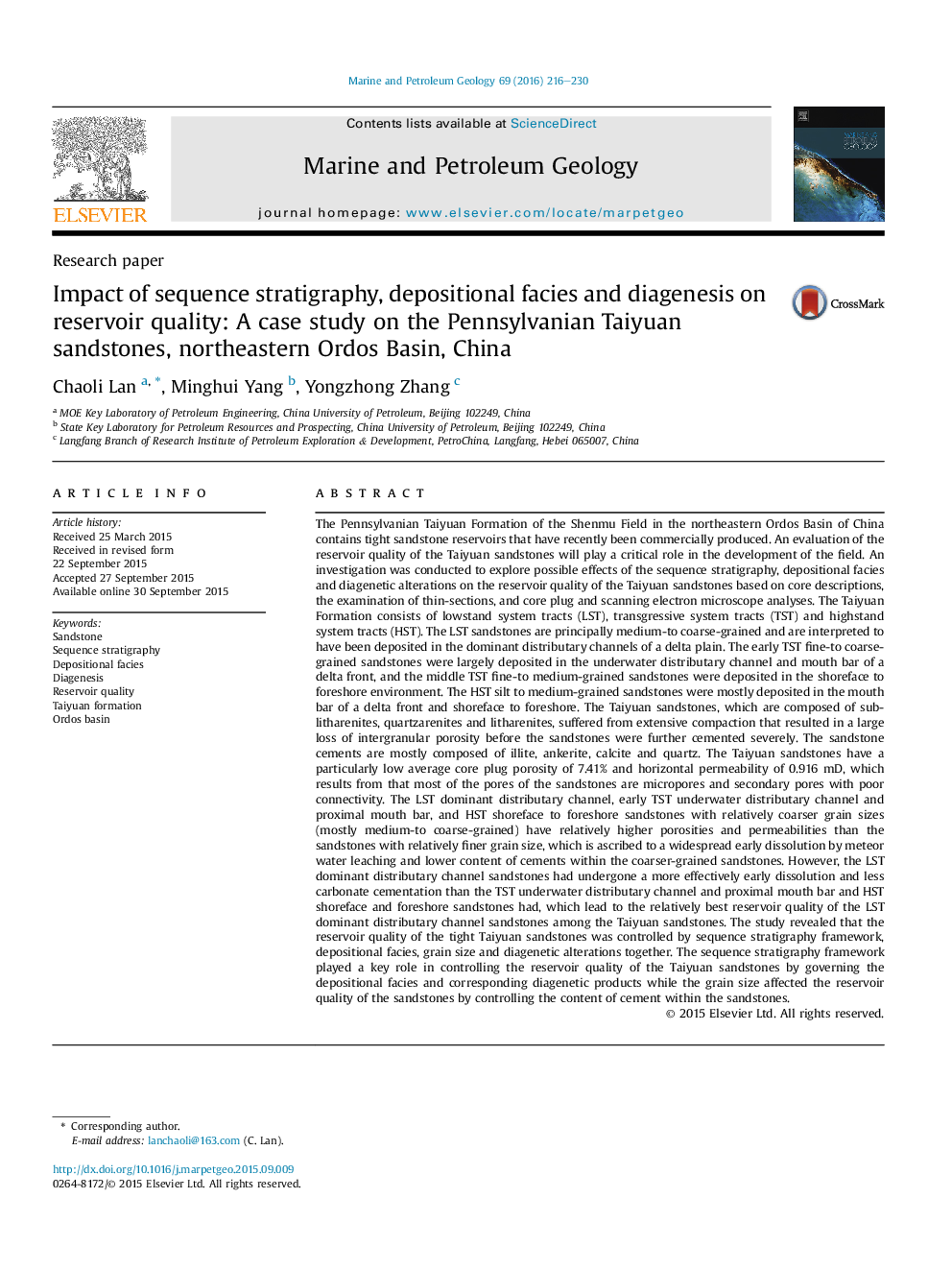| کد مقاله | کد نشریه | سال انتشار | مقاله انگلیسی | نسخه تمام متن |
|---|---|---|---|---|
| 4695475 | 1637158 | 2016 | 15 صفحه PDF | دانلود رایگان |

• The Taiyuan Formation consists of lowstand systems tracts (LST), transgressive systems tracts (TST) and highstand systems tracts (HST).
• The LST sandstones were mostly deposited in delta plain, the TST and HST sandstones in delta front and shoreface to foreshore.
• The Taiyuan sandstones suffered from extensive compaction and cementation with poor reservoir quality.
• The LST delta plain sandstones have a better reservoir quality than the delta front to shoreface and foreshore sandstones of TST and HST.
• The sandstone reservoir quality was controlled by sequence stratigrahy framework, depositional facies, grain size and diagenetic alterations.
The Pennsylvanian Taiyuan Formation of the Shenmu Field in the northeastern Ordos Basin of China contains tight sandstone reservoirs that have recently been commercially produced. An evaluation of the reservoir quality of the Taiyuan sandstones will play a critical role in the development of the field. An investigation was conducted to explore possible effects of the sequence stratigraphy, depositional facies and diagenetic alterations on the reservoir quality of the Taiyuan sandstones based on core descriptions, the examination of thin-sections, and core plug and scanning electron microscope analyses. The Taiyuan Formation consists of lowstand system tracts (LST), transgressive system tracts (TST) and highstand system tracts (HST). The LST sandstones are principally medium-to coarse-grained and are interpreted to have been deposited in the dominant distributary channels of a delta plain. The early TST fine-to coarse-grained sandstones were largely deposited in the underwater distributary channel and mouth bar of a delta front, and the middle TST fine-to medium-grained sandstones were deposited in the shoreface to foreshore environment. The HST silt to medium-grained sandstones were mostly deposited in the mouth bar of a delta front and shoreface to foreshore. The Taiyuan sandstones, which are composed of sublitharenites, quartzarenites and litharenites, suffered from extensive compaction that resulted in a large loss of intergranular porosity before the sandstones were further cemented severely. The sandstone cements are mostly composed of illite, ankerite, calcite and quartz. The Taiyuan sandstones have a particularly low average core plug porosity of 7.41% and horizontal permeability of 0.916 mD, which results from that most of the pores of the sandstones are micropores and secondary pores with poor connectivity. The LST dominant distributary channel, early TST underwater distributary channel and proximal mouth bar, and HST shoreface to foreshore sandstones with relatively coarser grain sizes (mostly medium-to coarse-grained) have relatively higher porosities and permeabilities than the sandstones with relatively finer grain size, which is ascribed to a widespread early dissolution by meteor water leaching and lower content of cements within the coarser-grained sandstones. However, the LST dominant distributary channel sandstones had undergone a more effectively early dissolution and less carbonate cementation than the TST underwater distributary channel and proximal mouth bar and HST shoreface and foreshore sandstones had, which lead to the relatively best reservoir quality of the LST dominant distributary channel sandstones among the Taiyuan sandstones. The study revealed that the reservoir quality of the tight Taiyuan sandstones was controlled by sequence stratigraphy framework, depositional facies, grain size and diagenetic alterations together. The sequence stratigraphy framework played a key role in controlling the reservoir quality of the Taiyuan sandstones by governing the depositional facies and corresponding diagenetic products while the grain size affected the reservoir quality of the sandstones by controlling the content of cement within the sandstones.
Journal: Marine and Petroleum Geology - Volume 69, January 2016, Pages 216–230